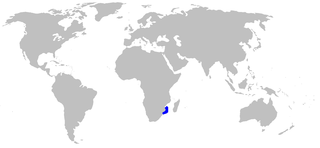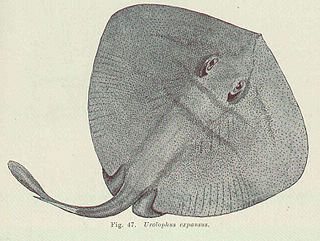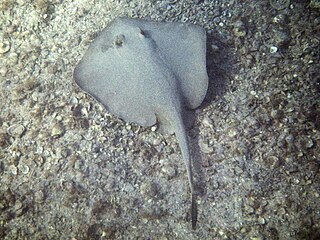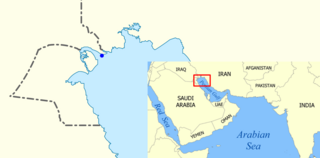
The prickly shark is one of the two species of sharks in the family Echinorhinidae, found in the Pacific Ocean over continental and insular shelves and slopes, and in submarine canyons. Bottom-dwelling in nature, it generally inhabits cool waters 100–650 m (330–2,130 ft) deep, but it also frequently enters shallower water in areas such as Monterey Bay off California. This stocky, dark-colored shark grows up to 4.0 m (13.1 ft) long, with two small dorsal fins positioned far back on its body and no anal fin. It is characterized by a dense covering of thorn-like dermal denticles, hence its common name.

The bramble shark is one of the two species of sharks in the family Echinorhinidae. Aside from the eastern Pacific Ocean, it is found in tropical and temperate waters worldwide. This rarely encountered shark swims close to the bottom of the seafloor, typically at depths of 400–900 m (1,300–3,000 ft), though it may enter much shallower water. The bramble shark has a stout body with two small dorsal fins positioned far back and no anal fin. It can be readily identified by the large, thorn-like dermal denticles scattered over its body, some of which may be fused together. It is purplish brown or black in color and grows up to 3.1 m (10 ft) long.

The New Zealand smooth skate is a skate of the genus Dipturus, found around New Zealand at depths between 15 and 1,300 m.

The balloon shark is a species of catshark, and part of the family Scyliorhinidae, endemic to the southwestern Indian Ocean off South Africa and Mozambique. Benthic in nature, it is found over sandy and muddy flats at depths of 40–600 m (130–1,970 ft). This thick-bodied species has a broad, flattened head and a short tail; its distinguishing traits include narrow, lobe-like skin flaps in front of the nostrils, and a dorsal color pattern of faint darker saddles on a light grayish background.

The slender catshark is a small species of catshark belonging to the family Scyliorhinidae. It is found on the upper continental slope off the coast of Suriname, French Guiana and northern Brazil, including the mouth of the Amazon River at depths between 72 to 450 metres. Its it can grow up to a length of 70 centimetres (28 in).

The Australian sawtail catshark is a common species of catshark, and part of the family Scyliorhinidae, endemic to southern Australian waters. It is found on or near the bottom of the outer continental shelf and upper continental slope, at depths of 85 to 823 m. This slim-bodied species is characterized by crests of enlarged dermal denticles along both the dorsal and ventral edges of its caudal fin and caudal peduncle, along with a color pattern of broad, dark saddles outlined in white. It can grow to 61 cm (24 in) in length. The Australian sawtail catshark feeds mainly on fishes, crustaceans, and cephalopods. Females are oviparous and lay eggs enclosed by capsules. This species is often caught incidentally by commercial bottom trawl fisheries, but is not significantly threatened by fishing activity. Thus, it has been assessed as of Least Concern by the International Union for Conservation of Nature (IUCN).

The Australian angelshark is a species of angelshark, family Squatinidae, found in the subtropical waters of southern Australia from Western Australia to New South Wales between latitudes 18°S and 41°S, at depths down to 255 m (840 ft). Its length is up to 1.52 m (5 ft). Reproduction is ovoviviparous, with up to 20 pups in a litter.

Dipturus is a large genus of skates native to the Pacific, Atlantic, and Indian Oceans. They were formerly included in Raja. Some species initially moved to Dipturus were later placed in Dentiraja, Spiniraja, and Zearaja.

The barndoor skate is a species of marine cartilaginous fish in the skate family Rajidae of the order Rajiformes. It is native to the northwestern Atlantic Ocean, and is found from the Grand Banks of Newfoundland and the southern side of the Gulf of St. Lawrence south to North Carolina. The fish is one of the largest skates found in the North Atlantic Ocean, reaching lengths up to 1.5 m (5 ft). It is carnivorous, feeding on invertebrates and other fish found near the sea floor.
The whitefin swellshark is a species of catshark, belonging to the family Scyliorhinidae, endemic to southeastern Australia. It is found 126–554 m (413–1,818 ft) down, on the outer continental shelf and upper continental slope. Reaching 1.1 m (3.6 ft) in length, this shark has a very thick body and a short, broad, flattened head with a large mouth. It is characterized by a dorsal color pattern of dark saddles and blotches over a brown to gray background, and light fin margins. When threatened the whitefin swellshark can inflate itself with water or air to increase its size. Reproduction is oviparous. As of 2019 The International Union for Conservation of Nature (IUCN) has assessed this species as Critically Endangered due to the significant decline of the population.

The pointy-nosed blue chimaera, also known as the pointy-nosed blue ratfish, Ray Troll's chimaera or abyssal ghostshark, is a species of deep-sea fish in the family Chimaeridae.
The longnose eagle ray or snouted eagle ray is a species of fish in the family Myliobatidae. It is found in the East Pacific Ocean from Baja California and the Gulf of California to Sechura, Peru, ranging from shallow water to a depth of 64 m (210 ft). This species was first described in 1964 by the American ichthyologist Shelton Pleasants Applegate, who was an expert on fossil and living sharks, and by American marine biologist John Edgar Fitch.

The wide stingaree is a little-known species of stingray in the family Urolophidae, found off southwestern Australia. It typically occurs over sand in water 200–300 m (660–980 ft) deep around the edge of the continental shelf. This species has a broad diamond-shaped pectoral fin disc, a slightly pointed snout, and a tail with a leaf-like caudal fin, skin folds along either side, and no dorsal fins. Between its nostrils is a skirt-shaped curtain of skin. It is grayish green above, with faint bluish lines beside and behind the eyes. The maximum length on record is 52 cm (20 in).

The greenback stingaree is a little-known species of stingray in the family Urolophidae, endemic to the outer continental shelf and upper continental slope off southeastern Australia. Growing to a length of 51 cm (20 in), this species has a diamond-shaped pectoral fin disc wider than long and uniformly light green in color above. Between its nostrils is a skirt-shaped curtain of skin. Its tail bears skin folds on either side and a deep, lanceolate caudal fin, but lacks a dorsal fin.

The shagreen ray, also known as shagreen skate or fuller's ray, is a species of skate in the family Rajidae. This ray is found in the eastern Atlantic Ocean, from Murmansk, Russia through Norway, southern Iceland, the Faroe Islands, the Celtic Sea, the northern North Sea and Skagerrak, to western Morocco and the Madeira archipelago, but not in the shallow waters off England and Wales. It is also recorded sporadically in the Mediterranean Sea.

The clearnose skate is a species of cartilaginous fish in the family Rajidae. R. eglanteria is also known by other common names such as the brier skate and summer skate. Clearnose skates are easily identified by the translucent patches on either side of their snouts and their mottled dorsal surface. They are found along the Atlantic and Gulf coasts of the United States in shallow waters of the continental shelf.

The pita skate is a medium-sized skate in the family Rajidae. The holotype and only known specimen was found in the northern Persian Gulf, in Iraqi waters. It was collected at a depth of less than 15 m (49 ft).
Dipturus teevani, commonly known as the prickly brown ray or Caribbean skate, is a species of cartilaginous fish in the family Rajidae. The prickly brown ray is medium in size compared to other skates, and is known from a patchy, deep-water distribution in the western Atlantic Ocean.
The greeneye spurdog is a species of dogfish described in 2007. It is a member of the family Squalidae, found off the coast of southeastern Australia. The length of the longest specimen measured is 85.6 cm (33.7 in). It was considered conspecific with the shortspine spurdog.

The Sydney skate is a species of skate of the family Rajidae native to waters off the east coast of Australia.

















